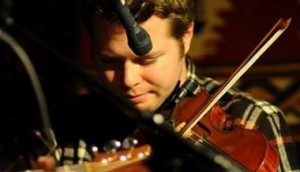For years to come, two words inevitably will precede Patrick Mangan’s name: “Riverdance fiddler.”
Which is OK by him.
Although he is well-grounded in traditional Irish music—and you’ll hear plenty of it Saturday night when he plays a concert at the Philadelphia Irish Center with friend and singer-guitarist Ryan McGiver—Riverdance is a major part of his life, and has been for a decade.
Mangan, born in Brooklyn and trained in the ways of New York Sligo-style fiddling by the great Brian Conway, first came to the attention of the show’s producers in 2000, when he was just 15, By that point in his life, he had already won the Fleadh Cheoil na hÉireann (the world competition of Irish music, also known as the All-Irelands) twice, in 1994 and 1997. He was young, but he’d already had experience on the world stage.
Riverdance was quite another thing altogether.
He remembers when he first considered trying out for the show. “I saw something in one of the New York Irish papers. It was just a little listing saying Riverdance was looking for substitute fiddlers for the show on Broadway,” he says. “So I recorded a little four-track demo and sent it in. They invited me to audition, and I remember playing in front of the show’s composer Bill Whelan and the piper Declan Masterson. (After that) I didn’t hear anything for almost a year. Then they invited me to audition again.”
It turned out that one not-so-little factor gave the show’s producers pause. “They had never had a male fiddler before. It broke the mold. Eileen Ivers had made it an iconic role for a female fiddler, and they were a little on the fence about that, but they decided to give it a shot.”
That was in 2001. He was 16.
That shot turned into a fill-in gig that Mangan wound up squeezing into his high school and, later, college schedule.
The relationship with Riverdance evolved into something deeper and longer-lasting not long after his graduation from Tufts with a degree in English, with a minor in music. The degree seemed like the right thing to do, and it played to his strengths, but after graduation Mangan still hadn’t settled on a career path.
And then Riverdance came calling again. “I had maintained the connection with them throughout high school and college. Then, just after graduation, a full-time spot opened up with the American touring company. I’ve been touring with them full-time since college. I’ve been all over the world. It’s lucky Riverdance came along when it did.”
(His long relationship with Riverdance also changed his life in another significant way. It’s where he met his future wife, fellow cast member and Russian dancer Natia Rtveliashvili. They were married in June of this year. At last count, there have been over 30 marriages among Riverdance cast members.)
Mangan came to Riverdance already well-schooled in the traditional style of fiddle play. In fact, because he was taught by Brian Conway, and Conway was mentored in part by Andy McGann—and McGann himself was schooled by Coleman—Mangan has been described as a “direct artistic descendant of early 20th-century Irish-American fiddler Michael Coleman.” It’s worth noting that Mangan himself, when he was very young, also played with McGann, and McGann’s contemporary Paddy Reynolds.
“Just to have that influence and those older musicians being so gracious and generous when I was growing up, i was very lucky to be growing up at that time,” Mangan says.
And because his parents were devotees of traditional music, there was never a time in Mangan’s young life that he was not exposed to the old tunes of Ireland. He recalls listening to the music from his stroller at the Irish festival in Snug Harbor on Staten Island.
His love of that form of music has never gone away. As much as Riverdance has helped him gain in popularity and name recognition—and it has done that—he’s eager to play the old style with his partner McGiver.
Still, Mangan began his fiddle schooling with classical music taught in the Suzuki method, and he maintained his familiarity with the classical throughout his childhood and high school.
Between his deep familiarity with both styles—traditional Irish and classical—Mangan says he felt well qualified to play the Riverdance style of Irish music, which is nothing like the way Michael Coleman played it. In addition, Mangan himself relishes many styles and types of music.
“Riverdance at its core is based in Irish music,” he says, “but it’s good to have a grounding in classical music. You can play in different styles if you have the technique. And I always enjoyed improvising. I’ve never had too much of a problem with that. When I first learned the (Riverdance) music, it was a fun challenge. By now, I’ve played it so many times, I could do it in my sleep.”
For Mangan, playing in the blockbuster Irish show that laid the groundwork for all the Celtic women and Irish tenors who would follow still holds his deep interest. In fact, he’s soon going to go out on the road with Riverdance again.
And that’s just fine with him, too.
“As many times as I’ve heard that music,” he says, “certain musical moments in the show still get to me. There’s a reason why that show has gone on as long as it has. It’s just amazing how much my life has been touched by it, how one thing has led to another.”

